

International
Labour Organization
Your health and safety at work
CHEMICALS IN THE WORKPLACE
IV. Obtaining and using information about industrial chemicals
It is your right to know!
One of the biggest problems for trade union health and safety representatives and workers is getting adequate information about chemicals used at work. The good news is that there are various sources of information about chemicals in your workplace.
Some of these sources are:
Often a single source will not tell you everything you need to know, therefore it is best to try to get information from as many of these sources as you can. Health and safety information on chemical substances is public, so you have the right to ask for the facts! These sources of information are looked at in more detail below.
What other sources |
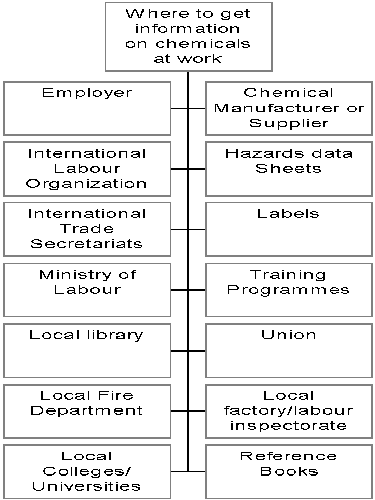 |
Many countries now have some kind of hazard information or right-to-know legislation. These laws make it the employer's legal responsibility to provide workers with as much information and training as possible on all chemical substances used. Some unions have negotiated agreements which require that the union be given full information on all chemicals used in the workplace. Unfortunately, many employers do not have this information and may not know where to get it. If this describes your situation, then the health and safety representative should insist that the employer obtains information from the chemical manufacturer or the supplier and makes it available to the workers.
If your employer cannot obtain the necessary information for you, then you or your union may want to write directly to the chemical manufacturer and request the information yourself. There follows a sample letter which you can modify for your own situation and use to request information directly from the chemical manufacturer or supplier.
Ask management for information. Make sure that the company fulfils its obligation to inform workers about workplace hazards. |
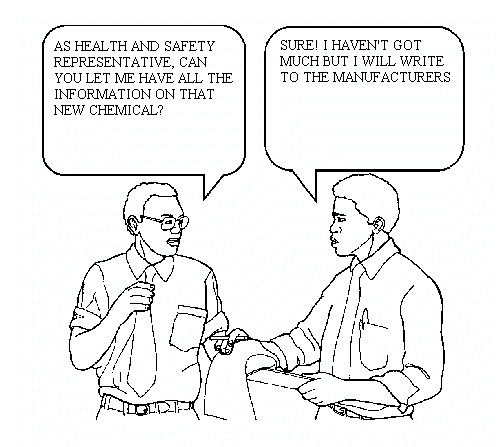 |
Sample letter requesting hazard data sheet and other technical information from chemical manufacturer
Date The Technical Directors Name and address of chemical manufacturer Dear Sir or Madam: I am writing to request information about the possible health hazards associated with one of your products: Trade name:............................................................................ Chemical name: (if known).................................................... I use this substance during the routine course of my work at (name and address of the company you work for). Could you please supply me with the following information: 1. What are the ingredients of (name of the chemical), the chemical formula of each ingredient, and the rough proportion in which they are mixed? Are there any known hazardous contaminants or by-products? 2. What harmful effects is (name of chemical) known to or suspected to cause in humans? Please include any reports on the effects of short-term and long-term exposure. 3. What was the level of concentration and length of exposure where any negative health effects were observed? 4. What precautions are recommended when working with or near (name of chemical)? 5. What precautions are recommended for storage, handling and transport? 6. What first-aid measures are recommended for any workers exposed to (name of chemical)? Thank you in advance for your assistance and cooperation in this matter and I look forward to receiving this information from you in the near future.
I remain, |
Many manufacturers are willing to cooperate, but if you do not get a response from them after a reasonable period of time and have sent reminders, then it may be necessary to recommend that your employer stops using the chemical. This should be made clear in one of the reminders to the manufacturer. At that point, it may be necessary to look for safer alternatives to the original chemical.
How to find a safer alternative to a dangerous chemical
Source: Health hazards in the electronics industry, lnternationai Metalworkers' Federation, Asia Monitor Resource Centre, Hong Kong, 1985.
For many chemicals, the evidence on toxicity is often not complete because of inadequate testing or failure to record all information about health effects. Thus, it is important to review every year or so the current literature on chemicals used at work. Always use the latest available edition of a textbook on toxic substances. The Internationai Registry of Potentially Toxic Chemicais (IRPTC), a division of the United Nations Environment Programme in Geneva, Switzerland, publishes the IRPTC Bulletin twice a year providing a summary of the latest news from dozens of countries on toxicity and legisiation with regard to specific chemicals.
If you would like information on chemicals and products that have been banned or restricted by governments, you can request the following United Nations document: Consolidated list of products whose consumption and/or sale have been banned, withdrawn, severely restricted or not approved by governments. Send your request to: United Nations Sales Section, New York, United States of America, or Geneva, Switzerland. Include the title and the international standard book number (ISBN 92-1-130145-9) and be sure to state that you would like the most recent edition of this document.
Hazard data sheets (HDSs) (sometimes called material safety data sheets (MSDSs) or chemical safety data sheets (CSDSs)) are detailed information sheets on chemicals. They are generally prepared and made available by chemical manufacturers, or programmes such as the International Programme on Chemical Safety (IPCS, which is a joint activity of the World Health Organization (WHO), the International Labour Organization (ILO), and the United Nations Environment Programme (UNEP)). HDSs are important and accessible sources of information on chemicals, but their quality can vary. If you use or plan to use HDSs, be aware of their limitations. For example, they are often difficult to read and understand. Another serious limitation is that they often do not contain enough information about the hazards and the necessary precautions you need to take when working with certain chemicals. To overcome these limitations, whenever possible use other sources of information together with HDSs. It is a good idea for health and safety representatives to keep a hazard data sheet on each chemical used in the workplace.
The following pages will give you an idea of the kind of information you should expect to find when you read an HDS. Not all HDSs will contain all of the information here and the order of sections may vary on different HDSs. Definitions of some of the important terms commonly used on an HDS are given in the Glossary in the Instructor's guide to the Modules.
The following information must appear on all hazard data sheets. However, the order of the information may be different from that described below.
Remember: You can request a copy of the HDS for any chemical you are exposed to on your job.
Section I: Identification of product and manufacturer
The name of the product is listed here by chemical name or by trade name. The name listed should be the same as the name that appears on the label.
Hazard data sheets must also list synonyms for the product or substance. Synonyms are other names by which the substance is known. For example, methyl alcohol is also known as methanol or wood alcohol.
Manufacturer identification: Includes manufacturer's (or supplier's) name, address, telephone number, the date the HDS was prepared and an emergency telephone number to call after business hours. It is a good idea to call the manufacturer for information before an emergency occurs.
Section II: Hazardous ingredients
For products which are mixtures, only those ingredients that appear on specified lists of hazardous chemicals and which make up one per cent (1%) or more of the product need to be listed. Carcinogens are an exception and must be listed if they make up one-tenth of one per cent (0.1%) of the mixture. The hazardous ingredients must be listed by their chemical names.
For each listed ingredient, the concentration limit to which you may be exposed must be indicated. Both the enforceable permissible exposure limit (PEL) and the recommended threshold limit value (TLV) must be listed on the HDS.
For more information on PELs and TLVs, refer to the Glossary in the Instructor's guide to the Modules.
Section III: Physical data
This section lists boiling point, vapour pressure, vapour density, melting point, appearance, odour, etc. The information in Section III helps you to understand how a chemical behaves and the kind of hazard it presents.
Section IV: Fire and explosion data
Section IV lists the flashpoint and flammable or explosive limits, and tells you how to extinguish a fire. The information in this section is needed to prevent, plan for and respond to chemical fires and explosions.
Section V: Reactivity data
Section V tells you whether or not the substance is stable and, if it is not, what hazards the instability presents. Section V lists incompatibles (substances which must not be placed or used together). This information is important for proper storage and handling of the product.
Section VI: Health hazard data
Routes of entry (inhalation, skin absorption or ingestion), acute and chronic health effects, signs and symptoms of exposure, whether the product is carcinogenic, medical problems made worse by exposure, and recommended first-aid/emergency procedures are all supposed to be listed under Section VI. In reality, Section VI is often incomplete and inadequate.
Section VII: Precautions for handling
Information needed to devise emergency response plans, clean-up procedures, safe disposal methods and necessary storage and handling precautions must be detailed in Section VII. Frequently, however, manufacturers sum up this information with a simple (and inadequate) statement such as “Avoid breathing vapour” or “Avoid skin contact”.
Section VIII: Control measures
Recommended methods of hazard control including ventilation, work practices and personal protective equipment (PPE) are detailed in Section VIII.
The type of respirator and the most resistant protective clothing and glove material for the product should be named. However, this information is often incomplete. Rather than recommend the most resistant protective material, the HDS may simply state that “impermeable” gloves and clothing should be used.
Section VIII tends to stress personal protective equipment rather than engineering controls.
Search the International Chemical Safety Cards
You can request HDSs from your employer, the chemical manufacturer, or from the International Programme on Chemical Safety Project, IPCS. You can write to the IPCS for hazard data sheets on specific chemicals at: International Programme on Chemical Safety, CH-1211 Geneva 27, Switzerland.
For more details on the identification, classification and labelling of chemicals, see the Chemical Safety Training Modules
Make sure you read and understand |
 |
Labels on chemical containers or drums are another important source of information. Labels should always be attached to the container, and the chemical listed on the label should be what is found in the container.
All chemical containers should |
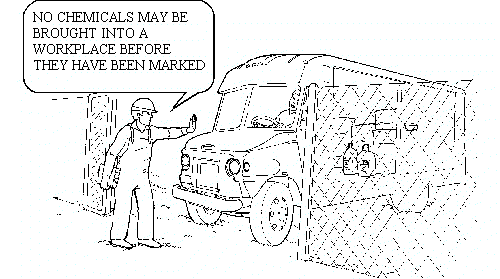 |
Like hazard data sheets, labels have limitations. For example, they can be incomplete, or a label may be written in a language you may not know, depending on the country where the chemical is produced. To overcome these limitations, it is best to use labels together with other sources of information.
Figure 3 is an example of both an inadequate label and a better label. Compare the two. What differences do you find? The inadequate label does not give the actual ingredients of the substance or the possible health effects from exposure; it does not tell you how to use the chemical safely or the telephone number of the manufacturer.
Figure 3.
Example of an inadequate label and a better label.
INADEQUATE LABEL Product name Chlorothane YU Hazard warning Hazard: Toxic by inhalation FIRST AID: If inhaled, remove to fresh air. If not breathing give artificial respiration, preferable mouth-to-mouth. If breathing is difficult, give oxygen. Call a physician. Responsible party Further information: Contact Solve x Chemicals. 1 Slime Rock Road, Chemtown, Michigan 06660 |
BETTER LABEL Product name Chlorothane YU Hazard warning Hazard: Toxic by inhalation Effects: Overexposure may result in Central Nervous System (CNS) effects including headache, dizziness, nausea, unconsciousness, death. Skin and eye irritant. Possible liver, kidney, cardiac effects. Use: Use only with proper
ventilation. FIRST AID: If inhaled, remove to fresh air. If not breathing, give artificial respiration. Call a physician. Responsible party In case of emergency, contact: Solve x Chemicals |
Notice that this label includes the actual chemical ingredients (1,1,1-trichloroethane) and spells out the “appropriate health hazards” in terms of the damages they can cause.
Source: Your Right to Know, United Autoworkers' Union, Detroit, Michigan, 1988.
It is important to know that
most industrial chemicals have two names: (1) a trade name by which the chemical is
commonly known, for example “Wonderglu” or “Supabat”, which does not
tell you anything about the chemical — it is simply the brand name used to advertise
the chemical; and (2) the chemical name which tells you the exact ingredients (the
ingredients are often in small writing on the label).
(See Figure 4.)
 |
SODIUMTRICHLOROACETATE |
| dangerous to health safety - hazards: dangerous to health, especially when swallowed! may decompose above 110ºC (230ºF) and form poisonous gases |
safety - directions
|
The chemical name does not change unless the ingredients are changed, but the trade name can change anytime. (For example, if an advertising campaign for a new chemical pesticide is not going well, or if reports from another country suggest that the chemical causes adverse health effects in workers, then the manufacturer can change the trade name, but not the chemical name. Try to get both names, but the chemical name is more important.)
In many workplaces, the chemicals used are often mixtures of different chemicals, or they may be contaminated with small traces of other chemicals that may be toxic. Both cases make it more difficult to obtain information, since HDSs only give information for pure chemicals, not mixtures, and contaminants are rarely given on a label. Chemical mixtures can be particularly dangerous if the substances react together or if they produce synergistic effects.
A label in Spanish would not be suitable for English -speaking workers and vice versa.
 |
PELIGRO Manténgase fuera del
alcance de los niños. VENENO Antídotos: Si es
ingerido, dése una cucharada de sal en un vaso de agua tibia y repítase hasta que el
vómito fluya claro. ENVASE Descontamine y destruya
el envase vacio, perforándolo, aplastándolo o quemándolo. ADVERTENCIA Debido a que Velsicol Chemical Corp. no tiene control sobre el almacenamiento, manipuleo y condiciones en que se usará esta formulación, lo que es de crítica importancia, Velsicol Chemical Corp. no se hace responsable expresa o implícitamente ni por los resultados ni por residuos mayores que los tolerados que pudieran haber sido establecidos por las oficinas gubernamentales, debido al mal uso, manejo o almacenamiento inapropiado de este material. Velsicol Chemical Corp. tampoco asume ninguna responsabilidad por daños causados a personas, cosas, animales, suelos o propiedades, consecuencia de un mal uso, inapropiado manejo o almacenamiento de este material. La casa garantiza el contenido de este envase pero no se hace responsable en forma alguna, por el uso que se haga del mismo, quedando éste exclusivamente a riesgo del comprador. |
ACCION, USOS Y RECOMENDACIONES MODO DE ACCION El Heptacloro 5 G actúa por acción directa, estomacal y de contacto. APLICACION Sobre el suelo o incorporado al mismo durante las labores de preparación o en el surco previo a la siembra. RECOMENDACIONES
|
Effective training is an important means of providing information on chemical hazards. If you work with chemicals, your employer should provide you with training for the chemicals you use. Training should include:
Training is essential for new workers and existing workers should receive refresher courses periodically. It is recommended that your union work together with the employer in developing and planning company-sponsored training programmes to make sure they are effective.
Training is essential for new workers. Existing workers should receive refresher courses periodically. |
 |
One of the other ways of identifying chemical hazards in the workplace is by keeping a record of complaints from co-workers: an increased amount of sickness or strange symptoms among workers; etc. These indicators could tell you there is a need to identify and investigate particular chemical hazards in the workplace. Air monitoring can tell you what the levels of chemicals are in the workplace but it can be extremely difficult to get both the monitoring equipment and the trained personnel. Another effective way to identify hazards is to do an inspection of your workplace, noting all chemicals used and the positions of workers, machines, ventilation (windows, etc.), storage areas, etc. (you may find it helpful to make a simple diagram of the workplace).
Note: Even if air monitoring is done, you should still do the inspection because it will provide you with information air monitoring cannot give you.
Try to answer the following questions during your inspection:
What chemicals are used in your workplace, including the various work processes and in maintenance work? Try to get information from container or drum labels and hazard data sheets.
What are the exact names of the chemicals? Try to find out both the trade names and the chemical names.
How long has each chemical been in use and how often is it used? For example, is it used only on certain shifts? This information is important because you may find a connection between the use of a chemical and certain workers who have health complaints.
How many workers are exposed to the chemical and for how long?
Have any workers noticed any health changes that might be connected to the use of certain chemicals?
Where is the chemical used and how is it stored?
What is the chemical used for cleaning, spraying, etc.?
Is it a solid, liquid, gas? Does it change its form during use (from wood to sawdust, for example)?
What do your senses tell you — can you see, smell or feel the chemical? Does it irritate your eyes, give you headaches, etc.?
What measures have been introduced to prevent exposure to the chemical hazard?
If you work with chemicals, your employer should make sure that you are in a company-sponsored medical surveillance programme.
If your employer will not sponsor a medical surveillance programme, then your union may want to take on this responsibility.
If you work with chemicals then you should be in a company-sponsored medical surveillance programme. |
 |
H. Other sources of information
Besides your employer, the chemical manufacturer or the supplier, there are other sources that may be able to help you get information on specific chemicals:
See the links to international and national information sources.
CHEMICALS

Reference books are another source of information. Texts on occupational health and safety may be available at your union headquarters, a labour college, public libraries or at the Ministry of Labour. Three books in particular are useful reference sources:
1. ILO encyclopaedia of occupational health and safety, 4th edition, Geneva, ILO, 1993, 2 volumes.
2. N.I. Sax: Dangerous properties of industrial materials, New York, Van Nostrand, 7th edition, 1988.
3. J.M. Stellman and S.M. Dawn: Work is dangerous to your health, New York, Random House, 1973.
Once you identify the chemical hazards in your workplace, the next step is to reduce or eliminate them altogether. There are a number of ways to work towards this goal using the information you collect.
The role of a health and safety representative dealing with chemicals. |
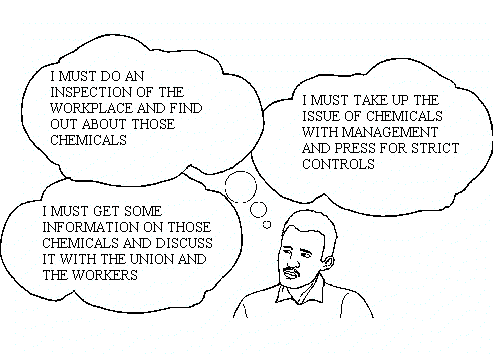 |
 |
Points to remember about obtaining and using information about industrial chemicals |
|
|
V. Role of the health and safety representative
Health and safety representative |
 |
If there are hazardous chemicals in your workplace, it is particularly important for you to work proactively (to take action before there are health problems or accidents) to help prevent workers from being exposed. Actions should be directed at making sure that proper control measures are in place, ensuring that workers are informed and trained on how to work safely with chemical substances, and at reducing or eliminating chemical hazards altogether.
Use the Chemicals check-list at the back of this Module to help you assess the chemicals used in your workplace. Here are some steps to help you reach your goals:
You have a better chance of protecting workers and eliminating hazards if you work with an informed employer. Therefore, as you learn more about chemical hazards in your workplace, you may need to educate your employer as well as your co-workers.
Health and safety information on chemical substances is public, therefore it is your right to ask for the facts.
If you have written to a chemical manufacturer for information on substances they produce and have not received a response after a reasonable period of time, then you may want to recommend to the employer that he or she stops using the chemical. At that point you may want to start looking for safer alternatives to the original chemical.
It is recommended that health and safety representatives keep a hazard data sheet (HDS) on each chemical used in the workplace, as well as HDSs or other information on any possible contaminants or chemical by-products.
Try to work together with the employer in developing and planning the content of company-sponsored worker training programmes. Some unions have been able to negotiate contract language that requires their approval on the content and teaching methods used in company training programmes. Your union's involvement will help to ensure good quality training programmes and help to protect workers' health in the long term.
Work with the union and the employer to make sure the atmosphere in the workplace is monitored regularly for levels of hazardous chemicals. Ask for the results of the monitoring. If the employer or union does not have personnel trained to do air monitoring, then the local factory inspectorate may be able to help you.
There are a number of ways to determine whether workers are being exposed to unsafe levels of chemicals. You can consult a variety of resources, request air monitoring to be done, check labels and HDSs, request the results of biological and medical monitoring (with the permission of the workers being monitored), conduct worksite inspections, talk to co-workers and find out if they have health complaints that may be related to chemical use, etc.
Work together with your union and employer to make changes based on the results of your investigations.
Are workers paid “dirt” or “danger” money to do particularly hazardous jobs in your workplace? If so, is the money a substitute for health? Unions should try to eliminate this practice. Particularly hazardous jobs should either be eliminated altogether or made safer with engineering controls.
Try to get your employer to provide laundry facilities so workers do not have to launder their work clothes at home. Workers should be educated about the importance of washing work clothes separately and not with the family's clothes. This is particularly important if workers receive laundry money from the employer.
 |
|
Exercise 1: Mapping
the chemical risks
in your workplace and planning for action
 |
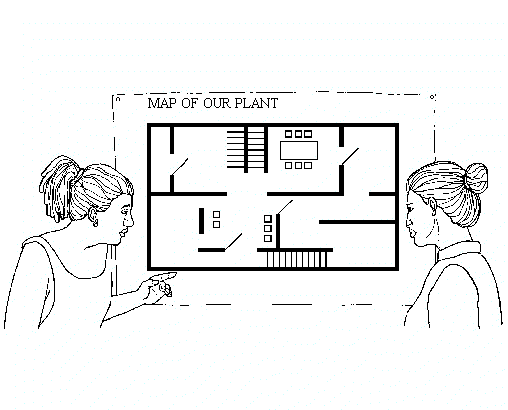 |
MAKE A MAP OF YOUR WORKPLACE
Note to the instructor
The purpose of this exercise is:
For this exercise, you will need to provide trainees with large pieces of paper, some markers and some tape to stick the maps to the walls.
For this exercise, you can choose one of these models or make up one of your own:
Workers from the same workplace can work together on one map.
If everyone is from the same workplace, then trainees can work in groups of three to five people and create several maps of the same workplace.
If everyone is from a different workplace, then trainees can make their own individual maps, or they can work together in small groups and make group maps of the chemical risks in their workplace and their plan for action.
Instructions
Ask the trainees to draw a map (a floor plan) of their work area, indicating the major work processes and where chemical hazards might be located.
Ask trainees to write or draw answers to the following questions on their maps:
In which locations are workers exposed to chemicals?
If you know what chemicals are used in the different work processes, write them on the map next to the place(s) where they are used.
How are the chemicals used during specific work activities?
What control measures are in place?
What control measures should be in place?
What are the different ways these chemicals can get into the body during the work process?
Have you or any of your co-workers experienced any health problems which you think may be related to chemicals? Write the symptoms next to the work process which may be causing the problems.
Which areas do you think are the most hazardous?
What actions can you and your union take to make these areas safer?
Once trainees have completed their maps, ask for volunteers to put their maps on the wall and indicate to the class which areas may be hazardous. Ask trainees to describe any controls that are used or that should be used. Discuss with the class strategies for action to improve the most hazardous areas. Trainees should then move on to develop an action plan.
PLAN A STRATEGY FOR ACTION
Instructions
Each trainee or small group of trainees should complete an action plan. For this exercise you will need to give each trainee or group of trainees a copy of the list of questions below.
Having identified the most hazardous areas, trainees should choose one problem that they want to work on first. The first step is to analyse the problem and answer the following questions:
What obstacles might you face when you try to make improvements in the situation?
Who will support you?
What can you do to involve other union members in your plan or to convince the union leadership to help you?
Answer the following questions to help you develop your action plan.
1. What are your immediate goals?
................................................................................................................................................
................................................................................................................................................
2. What are your long-term goals?
................................................................................................................................................
................................................................................................................................................
3. Who might help you?
(a) What information do you have access to?
(b) Is there a network for communicating with workers and the union?
(c) What are your chances for success?
................................................................................................................................................
................................................................................................................................................
4. What barriers might you face in working with management?
................................................................................................................................................
................................................................................................................................................
5. What are the first few steps you plan to take toward achieving your goals?
................................................................................................................................................
................................................................................................................................................
Exercise 2: Case-study on chemical hazards
 |
Note to the instructor For this exercise, you will need to give each trainee or each group of trainees a copy of the following materials included in the exercise:
If you cannot make copies, then read the case-study and other information to the class. Instructions Trainees should work in small groups of three to five people. They should read the case-study with their group, then answer the questions together with the group. Ask them to write down possible solutions and then look at the list of suggested solutions attached to the case-study. Can they add to the list? The problem In workplace XYZ, a number of workers dip machine parts into a degreasing tank for eight hours a day. The process uses a common solvent called 1,1,1-trichloroethane (TCA). There are no engineering controls around the degreasing tank, there is no local exhaust ventilation, and workers are not provided with any personal protective equipment. The workers have never received any information or training about the substance in the tank. A number of workers on the degreasing process have complained of headaches, dizziness, nausea and drowsiness. Most of the workers say that the symptoms disappear in the evening but return when they go back to work in the morning. They also notice that they do not experience these symptoms during weekends and holidays. The health and safety representative is very concerned because the management has threatened to dismiss several of the workers, claiming that they have been drunk on the job. What short-term and long-term solutions can you suggest for this problem? Facts about TCA TCA looks like water and has a mild sweet odour similar to that of chloroform or ether. TCA is much heavier than air, so it can collect in very high concentrations in the degreasing tank. TCA most commonly affects the nervous system, causing headaches, nausea, dizziness, drowsiness, and symptoms similar to drunkenness. TCA can also irritate the eyes, nose and skin. |
Figure 1. |
 |
Figure 2. |
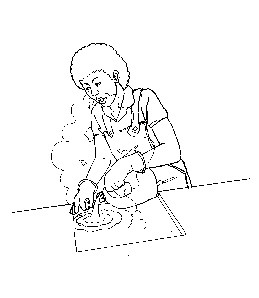 |
 |
| BEFORE | AFTER |
You can refer to the Module Controlling hazards for information to apply to this case-study.
Here are some suggested solutions.
Short-term solutions
Find a safer substitute for the chemical. Something as simple as soap solutions may work in the short term.
Isolate the work process by moving it to a well ventilated area.
Enclosure: cover the tanks when they are not being used. This will prevent vapours from escaping into the air.
Install fans behind the tank so that the vapours will be pushed away from the workers' breathing area.
Insist that the employer provide respirators and protective clothing, including gloves, aprons and face shields for protection against splashes, for the workers.
Administrative controls: rotate workers so their exposure time is decreased.
Long-term solutions
Eliminate the chemical altogether.
Engineering controls: effective local exhaust ventilation - hoods or flexible suction hoses - should be installed to draw the vapours away from the worker.
Make sure the work process is performed only in a well ventilated area.
Ask management for information on the chemical.
Write to the chemical manufacturer for information on the chemical.
Insist that the employer provide information and training to the workers.
Negotiate contract language that gives workers the right to refuse extremely dangerous work.
Points for discussion If the employer will not implement any of the immediate solutions, should the workers exercise the right to refuse hazardous work? (If the workers continue to work with the chemical without any protections, they will continue to experience ill health effects.) Can you add any other solutions to these lists? |
Exercise 3: Making a hazard data sheet
 |
Note to the instructor For this exercise, you will need to give a copy of the list of questions to each trainee. Trainees can do this exercise individually or in groups. Instructions Using any reference material available (books, labels, etc.), trainees should make up a hazard data sheet on any chemical they work with by answering as many of the following questions as possible. When everyone has completed the form, discuss some of the hazard data sheets with the whole class. Some trainees may need to report back to the class at a later time after they have talked to fellow workers or even management for some of the answers. Questions 1. Trade name of chemical ............................................................................................................................... 2. Chemical name ............................................................................................................................... 3. Manufacturer (address) ............................................................................................................................... 4. Has the supplier or manufacturer provided information on use of chemical? If so, try to get a copy ............................................................................................................................... 5. Brief description of way in which chemical is used ............................................................................................................................... 6. What form is the chemical in (dust, liquid,etc.)? ............................................................................................................................... 7. How long has it been used? ............................................................................................................................... 8. How many workers are exposed? ............................................................................................................................... 9. Have any complaints been received? If so, how many? ............................................................................................................................... 10. Are any recommendations given for the safe use of the chemical? (Give details) ............................................................................................................................... 11. What precautions are recommended for transportation, handling or safe storage? ............................................................................................................................... 12. Is the substance toxic? (Give details) ............................................................................................................................... 13. Is the substance flammable? (Give details) ............................................................................................................................... 14. What are the likely routes of entry? ............................................................................................................................... 15. What are the known or suspected acute and chronic effects of the chemical? ............................................................................................................................... 16. What are the recommended control measures? ............................................................................................................................... 17. Have all workers been informed of the dangers of using this substance and the precautions they need to take? ............................................................................................................................... 18. What first-aid procedures are necessary? ............................................................................................................................... 19. What waste disposal methods are recommended? .............................................................................................................................. |
 |
Note to the instructor Provide each trainee with a copy of the check-list and instructions. Instructions
|
When evaluating your workplace, check for the following:
| YES | NO | PRIORITY | ||
| Safe procedures and practices | 1. Are all chemicals clearly labelled with the name and origin of the chemical, name of the supplier, the danger symbol(s), hazard information, and advice for using the chemical safely? | |||
| 2. Have chemicals been relabelled if they have been transferred into smaller containers? | ||||
| 3. Are labels and instructions on chemical containers in a language that workers understand? | ||||
| 4. Are all chemicals stored in appropriate, safe containers? | ||||
| 5. Are chemical storage areas well ventilated and located away from sources of ignition? | ||||
| 6. Are appropriate devices used to allow the safe transport and transfer of chemicals? | ||||
| 7. Are small spills cleaned up immediately? | ||||
| 8. Is monitoring done to ensure the area is safe to continue work? | ||||
| 9. Are chemical wastes, including empty containers that have had chemicals in them, properly disposed of so that they do not present a risk to workers or the environment? | ||||
| 10. Does management inform workers of proper procedures for the safe storage, transportation and disposal of chemicals? | ||||
| Control methods | 11. Can toxic chemicals be substituted with less toxic ones? | |||
| 12. Are processes that emit dusts, vapours or mists isolated? | ||||
| 13. Are processes that emit dusts, vapours or mists enclosed? | ||||
| 14. Are there local ventilation systems operating? | ||||
| 15. Do they reduce contaminants in the work area? | ||||
| 16. Does natural ventilation provide adequate air exchange? | ||||
| 17. Are there fans and/or mechanical devices operating to improve general ventilation? | ||||
| Hazard identification | 18. Are flammable chemicals stored in such a way as to prevent the formation of flammable or explosive mixtures? | |||
| 19. Are there any open flames near where flammable chemicals are used, transferred or stored? | ||||
| 20. Are floor areas, work benches and machinery surfaces clean and free from oil deposits and dusts? | ||||
| 21. Are passageways well marked and free of debris? | ||||
| 22. Are storage racks provided around work stations for raw materials and finished products? | ||||
| Personal protective equipment (PPE) | 23. Is PPE provided only when other methods of control cannot eliminate the risk of workers being exposed to chemicals? | |||
| 24. Is PPE well maintained and inspected regularly? | ||||
| 25. Are workers provided with appropriate eye and skin protection when there is a possibility of chemical splash? | ||||
| Exposure monitoring | 26. Is there a person designated to monitor workers' exposure at regular intervals? | |||
| Medical surveillance | 27. Are pre-employment medical examinations required for workers assigned to hazardous chemical areas? | |||
| 28. Are workers handling hazardous chemicals given regular medical examinations? | ||||
| Training and education | 29. Are new workers given adequate training on the hazards of the chemicals they work with, safe work practices and emergency procedures? | |||
| 30. Are existing workers given periodic refresher training? | ||||
| 31. Are workers trained in the use, maintenance and storage of PPE? | ||||
| Emergency measures | 32. Is emergency equipment (eye baths, emergency showers) in good working order? | |||
| 33. Are they strategically located? | ||||
| 34. Are fire extinguishers appropriate for dealing with chemical fires available in sufficient number? | ||||
| 35. Is there a team on every shift that is trained to extinguish small chemical fires? | ||||
| 36. Are all workers trained in fire evacuation procedures and drilled regularly? | ||||
| 37. Is there a person on every shift who is trained to provide first aid? | ||||
| 38. Are first-aid boxes and other first-aid equipment well equipped, clearly marked, and in sufficient number? | ||||
| Management of chemicals | 39. Is there a person or committee appointed to plan and coordinate activities on chemical safety? | |||
| 40. Does the employer have hazard data sheets on all chemicals used in the workplace? | ||||
| 41. Are workers and the union involved in health and safety activities related to the safe management of chemicals? |